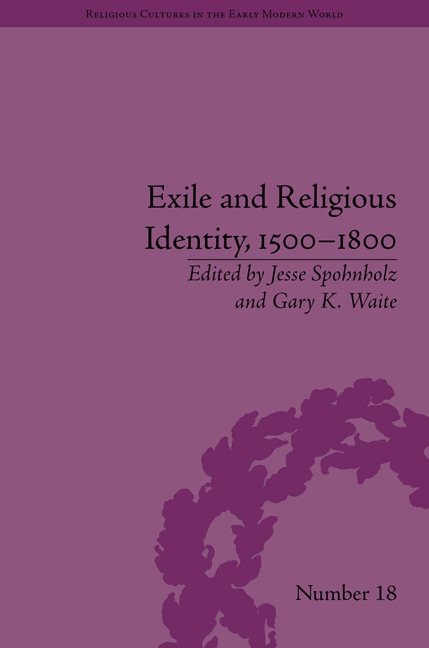Book contents
- Frontmatter
- CONTENTS
- Acknowledgements
- List of Contributors
- List of Figures and Tables
- Introduction
- Part I The Experience of Exile and the Consolidation of Religious Identities
- 1 ‘Count Every Step in my Flight’: Rhegius's and Luther's Consolations for Evangelical Exiles, 1531–3
- 2 Saints beyond Borders: Relics and the Expatriate English Catholic Community
- 3 Religious and Family Identity in Exile: Anne Percy, Countess of Northumberland in the Low Countries
- 4 The Reformed of Orange: Community Identity and Exile
- Part II The Experience of Exile and the Destabilization of Religious Identities
- Part III The Memory of Exile
- Notes
- Index
2 - Saints beyond Borders: Relics and the Expatriate English Catholic Community
from Part I - The Experience of Exile and the Consolidation of Religious Identities
- Frontmatter
- CONTENTS
- Acknowledgements
- List of Contributors
- List of Figures and Tables
- Introduction
- Part I The Experience of Exile and the Consolidation of Religious Identities
- 1 ‘Count Every Step in my Flight’: Rhegius's and Luther's Consolations for Evangelical Exiles, 1531–3
- 2 Saints beyond Borders: Relics and the Expatriate English Catholic Community
- 3 Religious and Family Identity in Exile: Anne Percy, Countess of Northumberland in the Low Countries
- 4 The Reformed of Orange: Community Identity and Exile
- Part II The Experience of Exile and the Destabilization of Religious Identities
- Part III The Memory of Exile
- Notes
- Index
Summary
His Tombe then was a monument able to preserve the memory of him [Thomas Cantilupe]; now we must endeavour to erect another able to preserve the memory of it, the graces receiv'd requiring this gratitude: hoping that as his honour and veneration fell with the last, (for it lasted as long as did the Catholique Religion in our land) so it will rise with the first in its restauration, when ever it shall please god in his mercy to send that happy houre.
This consideration motivated the English Jesuit Richard Strange (c. 1611–82) to write the life of Thomas Cantilupe, thirteenth-century bishop of Hereford. In Strange's opinion the Reformation in England had necessitated creating a substitute for the medieval stone tomb. Strange nonetheless expressed confidence that God would return England to the Catholic fold, and he intended his book to preserve the saint's memory in the interim. His words encapsulate the themes of the following discussion of devotion to saints among English Catholics on the continent: confidence in the future, an urge to maintain a continuous veneration, and the quest for means other than tombs erected upon English soil.
This essay focuses on the role of relics for the English Catholic community on the continent, and indicates how the particularities of their function and their meaning in an expatriate context offer insights into the lives and understanding of Catholics abroad.
- Type
- Chapter
- Information
- Exile and Religious Identity, 1500–1800 , pp. 25 - 38Publisher: Pickering & ChattoFirst published in: 2014

